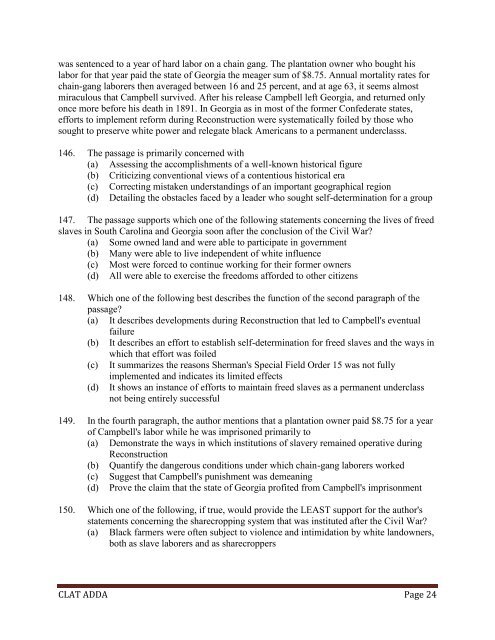NALSAR University of Law, Hyderabad ENTRANCE TEST PAPER ...
NALSAR University of Law, Hyderabad ENTRANCE TEST PAPER ...
NALSAR University of Law, Hyderabad ENTRANCE TEST PAPER ...
You also want an ePaper? Increase the reach of your titles
YUMPU automatically turns print PDFs into web optimized ePapers that Google loves.
was sentenced to a year <strong>of</strong> hard labor on a chain gang. The plantation owner who bought his<br />
labor for that year paid the state <strong>of</strong> Georgia the meager sum <strong>of</strong> $8.75. Annual mortality rates for<br />
chain-gang laborers then averaged between 16 and 25 percent, and at age 63, it seems almost<br />
miraculous that Campbell survived. After his release Campbell left Georgia, and returned only<br />
once more before his death in 1891. In Georgia as in most <strong>of</strong> the former Confederate states,<br />
efforts to implement reform during Reconstruction were systematically foiled by those who<br />
sought to preserve white power and relegate black Americans to a permanent underclasss.<br />
146. The passage is primarily concerned with<br />
(a) Assessing the accomplishments <strong>of</strong> a well-known historical figure<br />
(b) Criticizing conventional views <strong>of</strong> a contentious historical era<br />
(c) Correcting mistaken understandings <strong>of</strong> an important geographical region<br />
(d) Detailing the obstacles faced by a leader who sought self-determination for a group<br />
147. The passage supports which one <strong>of</strong> the following statements concerning the lives <strong>of</strong> freed<br />
slaves in South Carolina and Georgia soon after the conclusion <strong>of</strong> the Civil War?<br />
(a) Some owned land and were able to participate in government<br />
(b) Many were able to live independent <strong>of</strong> white influence<br />
(c) Most were forced to continue working for their former owners<br />
(d) All were able to exercise the freedoms afforded to other citizens<br />
148. Which one <strong>of</strong> the following best describes the function <strong>of</strong> the second paragraph <strong>of</strong> the<br />
passage?<br />
(a) It describes developments during Reconstruction that led to Campbell's eventual<br />
failure<br />
(b) It describes an effort to establish self-determination for freed slaves and the ways in<br />
which that effort was foiled<br />
(c) It summarizes the reasons Sherman's Special Field Order 15 was not fully<br />
implemented and indicates its limited effects<br />
(d) It shows an instance <strong>of</strong> efforts to maintain freed slaves as a permanent underclass<br />
not being entirely successful<br />
149. In the fourth paragraph, the author mentions that a plantation owner paid $8.75 for a year<br />
<strong>of</strong> Campbell's labor while he was imprisoned primarily to<br />
(a) Demonstrate the ways in which institutions <strong>of</strong> slavery remained operative during<br />
Reconstruction<br />
(b) Quantify the dangerous conditions under which chain-gang laborers worked<br />
(c) Suggest that Campbell's punishment was demeaning<br />
(d) Prove the claim that the state <strong>of</strong> Georgia pr<strong>of</strong>ited from Campbell's imprisonment<br />
150. Which one <strong>of</strong> the following, if true, would provide the LEAST support for the author's<br />
statements concerning the sharecropping system that was instituted after the Civil War?<br />
(a) Black farmers were <strong>of</strong>ten subject to violence and intimidation by white landowners,<br />
both as slave laborers and as sharecroppers<br />
CLAT ADDA Page 24


